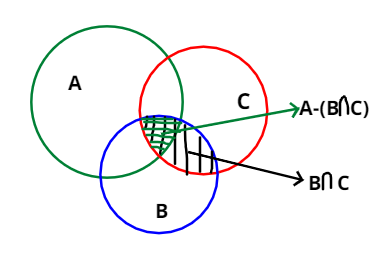
If \[{\text{A}} = \{ 10,15,20,25,30,35,40,45,50\} \],
\[{\text{B}} = \{ 1,5,10,15,20,30\} \] and
\[{\text{C}} = \{ 7,8,15,20,35,45,48\} ,\] find \[{\text{A}} - ({\text{B}} \cap {\text{C}})\].
Answer
612.3k+ views
Hint:- Draw Venn’ diagram. First find \[{\text{B}} \cap {\text{C}}\].

As, we are given with three sets and that were,
\[ \Rightarrow {\text{A}} = \{ 10,15,20,25,30,35,40,45,50\} ,\]
\[ \Rightarrow {\text{B}} = \{ 1,5,10,15,20,30\} \] and
\[ \Rightarrow {\text{C}} = \{ 7,8,15,20,35,45,48\} \]
And asked to find \[{\text{A}} - ({\text{B}} \cap {\text{C}})\].
And as we know that in set theory \[ \cap \] depicts intersection.
\[ \Rightarrow \]An intersection of two sets gives us the common elements of both sets.
So, \[{\text{B}} \cap {\text{C}}\] will give us common elements of sets B and C
\[ \Rightarrow \]So, \[{\text{(B}} \cap {\text{C) }} = {\text{ }}\{ 1,5,10,15,20,30\} \cap \{ 7,8,15,20,35,45,48\} = \{ 15,20\} \]
As we know that if X and Y are some sets then,
\[ \Rightarrow \]X-Y will give us a set having all elements of X excluding elements of Y.
So, \[{\text{A}} - ({\text{B}} \cap {\text{C}})\] will give us those elements of set A which are not in set \[{\text{(B}} \cap {\text{C)}}\]
\[ \Rightarrow \]\[{\text{A}} - ({\text{B}} \cap {\text{C}}) = \{ 10,15,20,25,30,35,40,45,50\} - \{ 15,20\} \]
\[ \Rightarrow \]Hence, \[{\text{A}} - ({\text{B}} \cap {\text{C}}) = \{ 10,25,30,35,40,45,50\} \]
Note:- Whenever we come up with this type of problem then first, we have to Draw Venn’s diagram because this will give proper clarity for the problem. Then remember that for any set X and Y, X-Y will give us a set having all elements of
X excluding elements of Y.

As, we are given with three sets and that were,
\[ \Rightarrow {\text{A}} = \{ 10,15,20,25,30,35,40,45,50\} ,\]
\[ \Rightarrow {\text{B}} = \{ 1,5,10,15,20,30\} \] and
\[ \Rightarrow {\text{C}} = \{ 7,8,15,20,35,45,48\} \]
And asked to find \[{\text{A}} - ({\text{B}} \cap {\text{C}})\].
And as we know that in set theory \[ \cap \] depicts intersection.
\[ \Rightarrow \]An intersection of two sets gives us the common elements of both sets.
So, \[{\text{B}} \cap {\text{C}}\] will give us common elements of sets B and C
\[ \Rightarrow \]So, \[{\text{(B}} \cap {\text{C) }} = {\text{ }}\{ 1,5,10,15,20,30\} \cap \{ 7,8,15,20,35,45,48\} = \{ 15,20\} \]
As we know that if X and Y are some sets then,
\[ \Rightarrow \]X-Y will give us a set having all elements of X excluding elements of Y.
So, \[{\text{A}} - ({\text{B}} \cap {\text{C}})\] will give us those elements of set A which are not in set \[{\text{(B}} \cap {\text{C)}}\]
\[ \Rightarrow \]\[{\text{A}} - ({\text{B}} \cap {\text{C}}) = \{ 10,15,20,25,30,35,40,45,50\} - \{ 15,20\} \]
\[ \Rightarrow \]Hence, \[{\text{A}} - ({\text{B}} \cap {\text{C}}) = \{ 10,25,30,35,40,45,50\} \]
Note:- Whenever we come up with this type of problem then first, we have to Draw Venn’s diagram because this will give proper clarity for the problem. Then remember that for any set X and Y, X-Y will give us a set having all elements of
X excluding elements of Y.
Recently Updated Pages
Why are manures considered better than fertilizers class 11 biology CBSE

Find the coordinates of the midpoint of the line segment class 11 maths CBSE

Distinguish between static friction limiting friction class 11 physics CBSE

The Chairman of the constituent Assembly was A Jawaharlal class 11 social science CBSE

The first National Commission on Labour NCL submitted class 11 social science CBSE

Number of all subshell of n + l 7 is A 4 B 5 C 6 D class 11 chemistry CBSE

Trending doubts
Differentiate between an exothermic and an endothermic class 11 chemistry CBSE

10 examples of friction in our daily life

One Metric ton is equal to kg A 10000 B 1000 C 100 class 11 physics CBSE

Difference Between Prokaryotic Cells and Eukaryotic Cells

1 Quintal is equal to a 110 kg b 10 kg c 100kg d 1000 class 11 physics CBSE

State the laws of reflection of light




